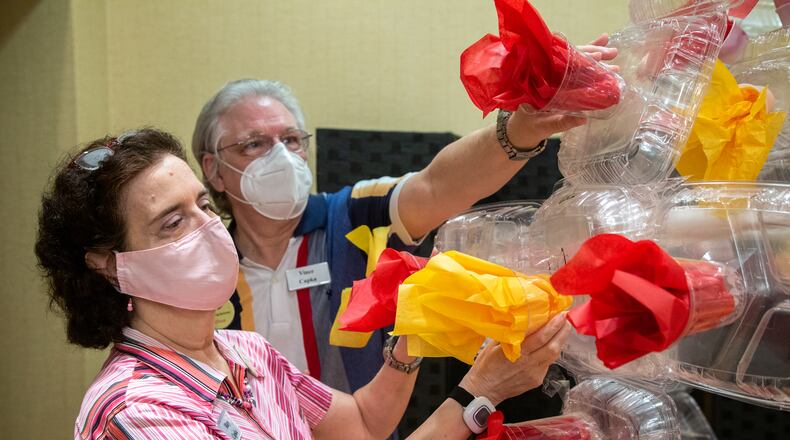One person’s plastic dinnerware can bring another person pleasure when it’s recycled into eye-catching art.
That’s what residents of Canterbury Court, a Buckhead senior retirement community, learned when they transformed a collection of gently used plastic food trays, containers, and cups into a roughly 6-feet-wide and roughly 10-feet high, pop-art vision of the novel coronavirus, the virus that causes the disease COVID-19.
“I thought the idea was great, and I fully supported it. But I had no idea how phenomenal it would be,” said Debi McNeil, president, and CEO of Canterbury Court. “What they put together was nothing short of a professional art installation.”
Canterbury’s COVID ball was the brainchild of Mary Capka, a retired nurse and kidney transplant recipient who has been in the community with her organ donor and husband, Vince, for three years.
Beginning in March, as people began to shelter in place and social distance, senior living communities across the state and nation – including Canterbury – closed their communal dining halls and started delivering meals to residents, most often in plastic.
The plastic ware used at Canterbury Court wasn’t recyclable, something that didn’t sit well with a community of seniors that’s big on recycling. And so, for months, Capka washed, stacked, and stored hundreds of these trays, containers and cups – hoping one day to put them to good use.
Finally, one day, Capka said she told her husband: “I’m going insane. Let’s do something. Why don’t we build something with these non-recyclable plastics?”
She threw out all sorts of ideas before deciding: What would be more appropriate than a virus particle?
Capka recruited the help of her husband, as well as four residents – LuAnne Schwarz, Karen Evans, retired master builder Fritz Toussaint, and second-generation Canterbury Court resident Martha Solano.
“I said: ‘Sure. Whatever’,” Solano recalled. “It wasn’t like we were doing a lot of things.”
Credit: Phil Skinner
Credit: Phil Skinner
Together, the six got creative – building the larger-than-life virus particle with tape, staples, wire, glue, fishhooks, fishing line and the plastic ware. To give it pizzazz, red and yellow paper was used to recreate the vibrantly colored spikes commonly seen in renderings of the coronavirus.
And they didn’t stop there.
They created an interactive component to their artwork – asking residents who came to eye the COVID ball to respond to three questions about the pandemic: What do you miss most? What are you looking forward to? And lastly, what did you learn from this once-in-a-lifetime experience?
Residents responded that they miss friends, family, socializing, dining out, and hugs. They said they are most looking forward to reconnecting, eating out, attending church, and reclaiming their freedom. Some said they expect to come out of the pandemic a little more tech-savvy – having learned to use Zoom and YouTube – and a little wiser, having realized they can be content with less busyness, less scheduling, and some alone-time.
“I think it was very therapeutic for a lot of the residents to talk about the fact they missed the interaction, they missed hugging and seeing their families,” McNeil said. “But they also learned that they are resilient, strong, and adaptable.”
The COVID ball was on display in Canterbury Court’s community room in June. Residents and staff were invited to check it out, provided they wore masks and adhered to strict rules on social distancing. Capka and her crew also made sure there were hand-sanitizing stations handy.
Residents “got a kick out of the fact that it was all recycled,” Solano said.
Aside from providing a much-needed break from the monotony of isolation, the COVID ball “offered a whimsical way to view a very trying situation and express residents' thoughts, fears, and frustrations,” Capka said.
“The danger persists,” she said, “and we continue to endure. But we are hopeful we can eventually overcome this crisis … [becoming] active seniors again with new wisdom gained from facing another of life’s inevitable curveballs.”
And what’s to become of the COVID ball?
It is in storage, and its future is uncertain.
But Capka said she hopes a decommissioning ceremony – symbolically killing the coronavirus – will be held once the pandemic restrictions are lifted, those categorized as vulnerable can go out again, “and we are getting back to the new normal life.”
WHAT INSPIRED MARY CAPKA?
What was the biggest challenge you had in creating the COVID-19 ball?
“Besides technical elements, the biggest challenge was to create something that brought
perspective and hope to seniors forced to be together alone. We hoped to create something that allowed us to touch each other in spirit in this no-touch world.”
Why do you think it meant so much to the community?
“Canterbury is an intrinsically caring, supportive community. Isolation is a terrible waste of life’s possibilities. Each day is a precious, limited gift. Our project helped seniors connect again with their ‘second family’ and share ourselves with those we care about.”
About the Author
Keep Reading
The Latest
Featured



